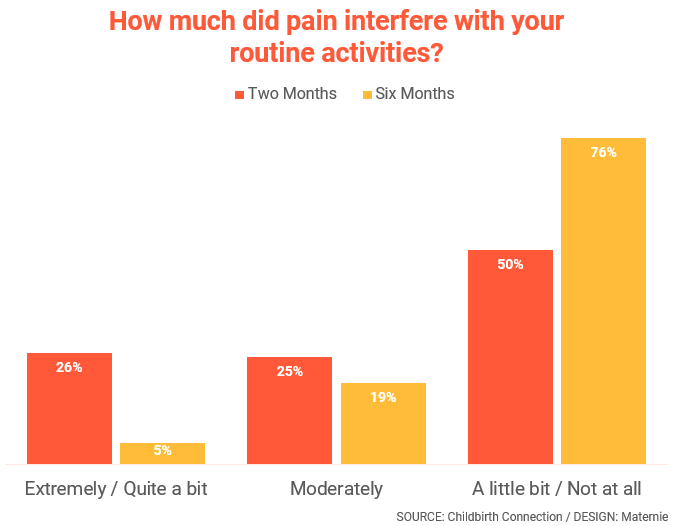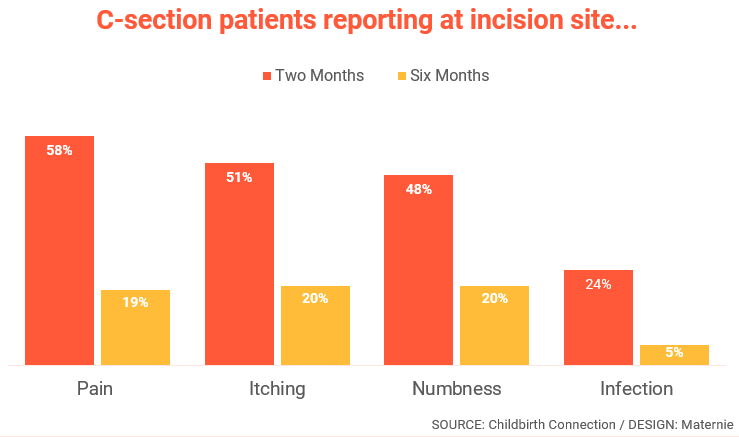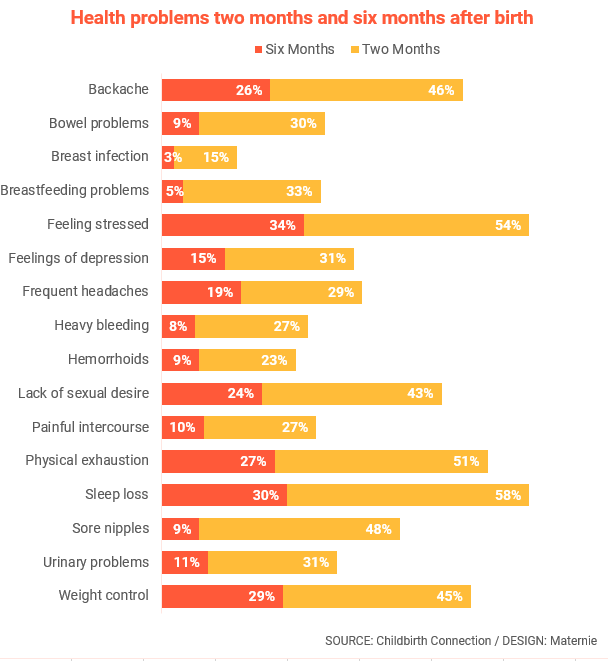Question: What are the signs and symptoms to watch for during C-section recovery after the first few days?
Our Quick Take
- Most medical resources and experts say around six weeks is the typical time for recovery from a C-section. But we found it surprising that some sources said there are NOT evidence-based guidelines on whether lifting something heavier than your baby (a common recommendation after surgery) is actually harmful. More details below.
- One of the best resources we found on what is typical for recovery (and what might not be typical) comes from a 2013 study of 2,400 American women who had given birth in the previous year. What made this study unique is that it asked mothers about health challenges they faced at two months and at six months postpartum.
- They found that more than 50% of C-section patients said pain was interfering with their daily activities within the two months after birth. That number dropped to 26% at the six month mark, a sizeable decrease but still a significant portion of the population.

- See more details from that study below, including what types of pain at incision site was common at two months versus six months.
- As C-sections become more common, there are more studies happening on pain relief and recovery. But two reviews from Cochrane found there isn’t enough evidence to say which pain medications after C-sections work best or if any alternative pain relief therapies work.
Jump to…
- What Reliable Medical Sources Say on Recovery
- Survey: What Is Normal C-Section Recovery? (And What’s Not…)
- On Painkillers and Alternative Pain Relievers
- Methodology/Sources
- Maternie Manifesto
Get your parenting questions answered now.
Don't search Facebook groups and dated news articles claiming they have THE answer. Privacy guaranteed.
Drop your email below:
What Reliable Medical Sources Say on Recovery
The goal of this section is to give you an idea on whether reliable sources on this topic offer consistent advice. In general, we found that there is consistency around the timeline for recovery.
UptoDate, a resource for physicians that is regularly updated with the latest scientific research, reports that “most women” will feel better at six weeks, but that numbness at the incision and “occasional aches and pains” can last for “several months.”
They say you should get in touch with health care providers if…
- You have a fever (over 100.4 F)
- If pain or bleeding “worsens”
- Severe headache or abdominal pain
- Difficulty breathing
- Oozing or drainage from incision, foul smell
The National Institutes of Health’s MedLinePlus says…
- Pain should decrease after 2 or 3 days, but most women will need pain medicine for up to two weeks
- At 4 to 8 weeks patients are generally ready to “regular activities”
WhatToExpect includes a detailed explanation of what kind of pain could be problematic: “Pain or tenderness in a specific spot of the incision (note that while some pain is normal for the first few weeks, it should be generalized — not pain that you pinpoint to a specific spot).”
They also point out that some doctors will say you should use ointment on the scar, while others will say to keep it dry.
Parents.com broke down recovery on a week by week basis. One physician pointed out that in addition to your body recovering from surgery, it can take a full six weeks for your uterus to contract back to its normal size.
Lifting What? Lacking Evidence on What’s Safe To Pick Up After C-Section
Several sources pointed out there is not strong evidence backing up one of the most common recommendations after a C-section: That patients should not pick up anything heavier than their baby for the first few weeks.
As UpToDate puts it: “These activities should probably be minimized in the first one to two weeks of wound healing, although there are no high-quality data regarding the impact of increased intraabdominal pressure on wound healing,” and they cite a 2009 study (!!!) that calls for more evidence-based recommendations.
It is not practical to expect every medical recommendation come backed with evidence that comes from a randomized-control trial–the gold standard of scientific research. But in this case, the authors of the 2009 study called for “well-designed studies to help guide us and our patients.”
In their patient education materials, the American College of Obstetricians and Gynecologists’ steers away from a specific weight limit for lifting, saying that patients should “allow time to heal before doing any strenuous activity.”
Lastly, Australian researchers conducted in-depth interviews with 32 women who had C-sections in 2010, aiming fill a gap they saw and “describe women’s accounts of recovery after caesarean birth, from shortly after hospital discharge to between five months and seven years after surgery.”
They found that 30 out of 32 women had difficulties following the advice they got for postoperative recovery. And the routine advice the women got, including avoiding heavy lifting or driving a car for 4 to 6 weeks, “may be well-meaning and supportive of new mothers in need of rest and recuperation, appears to be without a solid evidence base.”
Get your parenting questions answered now.
Don't search Facebook groups and dated news articles claiming they have THE answer. Privacy guaranteed.
Drop your email below:
Survey: What Is Normal C-Section Recovery? (And What’s Not…)
One of the best sources we found on what normal C-section recovery might look like was 2013 study of 2,400 American women who had given birth in the previous year. What made this study unique is that it asked mothers about health challenges they faced at two months and at six months postpartum.
They had a detailed battery of questions for C-section patients on what they felt or experienced at their incision site. As you can see below, symptoms improved by six months, but there is still a sizable population that is reporting pain, itching, and numbness at their incision site.

Women who had C-sections also reported that pain interfered with their normal activities at a higher rate than those who had vaginal births at two months. But by six months the numbers reporting pain interference were nearly identical between C-section and vaginal births.

The survey also covered lots of other health problems mothers experienced after birth. The following chart includes mothers who had either a C-section of vaginal delivery:

Get your parenting questions answered now.
Don't search Facebook groups and dated news articles claiming they have THE answer. Privacy guaranteed.
Drop your email below:
On Painkillers and Alternative Pain Relievers
A large search of existing research completed by the Cochrane Review in 2015 found that “no conclusions” can be made based off the existing evidence on what is the safest and more effective oral painkiller for patients recovering from C-section.
Researchers started with 63 articles that looked at pain after C-section, but eventually whittled that down to 8 trials that met their criteria. Those eight trials included 926 women, but the results were inconclusive and the authors called for more research to “compare different types of pain killers and in relation to different outcomes such as safety, efficacy and cost.”
In 2018, the American College of Obstetricians and Gynecologists issued recommendations for opioid use in C-section patients. The Wall Street Journal reported that recommendation was partly based on research from a 2017 study where doctors let patients pick the number of opioid pills they wanted, up to 40 maximum. They found that women requested 50% less than the normal prescription, and rarely requested refills.
In those recommendations, ACOG strongly emphasizes that doctors should “individualize” pain relief for C-section patients:
“Because of the variation in types and intensity of pain women experience during the early postpartum period, as well as the concern that 1 in 300 opioid-naive patients exposed to opioids after cesarean birth will become persistent users of opioids, a stepwise approach using a multimodal combination of agents can enable obstetrician–gynecologists and other obstetric care providers to effectively individualize pain management for women in the postpartum period.”
ACOG
In 2020, another Cochrane Review looked at “complementary and alternative” pain relief methods for C-section patients. They reviewed 37 studies including pain relief methods like acupuncture, aromatherapy, massage therapy, and even reiki. But they found that “results were not always completely or clearly reported, the studies had serious limitations, and the results lacked precision,” leading them to conclude that they could not be confident in their findings.
Get your parenting questions answered now.
Don't search Facebook groups and dated news articles claiming they have THE answer. Privacy guaranteed.
Drop your email below:
Methodology/Sources
We started researching this question in several medical and scientific research sources and journals, including PubMed, the American College of Obstetricians and Gynecologists, Cochrane Review, and UpToDate. We then used a structured Google search to find trustworthy media sources to gather additional information and parse what both experts and parents had to say on this question.
Most importantly: We are not doctors or health professionals! We are health and science reporters who are trained in looking at existing evidence and communicating that information as clearly and concisely as possible to non-medical experts. Questions? Email us at [email protected].
- UptoDate: C-Section delivery (Beyond the Basics)
- C-section: MedlinePlus Medical Encyclopedia
- National Partnership: Listening to Mothers III (Survey)
- Recovery After C-Section: Timeline and Tips | Parents
- C-Section Scars: Types of Incisions, Healing, Treatment & Removal (whattoexpect.com)
- Cesarean Birth | ACOG
- The Push for Fewer Opioids for New Mothers – WSJ
- Oral analgesia for relieving post‐caesarean pain – Mkontwana, N – 2015 | Cochrane Library
- Complementary and alternative therapies for post-caesarean pain | Cochrane
Maternie Manifesto
Our mission is to get parents the best information out there on the many important questions they encounter when raising children.
Sometimes there are clear-cut solutions. But often there is no perfect answer, and what works for one child may not work for another. Experts can and will have differing opinions, just like families will have different experiences.
That contradictory information can create stress and make an already difficult decision even harder. That’s where we come in.
We do the research for you, not only getting you science and evidenced-based information but explaining where there is–and isn’t–consensus among experts and parents. Our greatest hope is that this information will give you greater confidence in your parenting journey, saving you time and sanity along the way 🙂